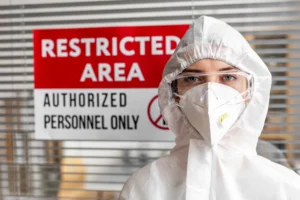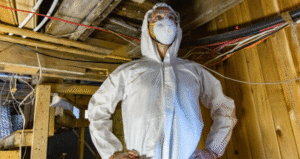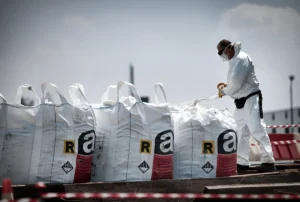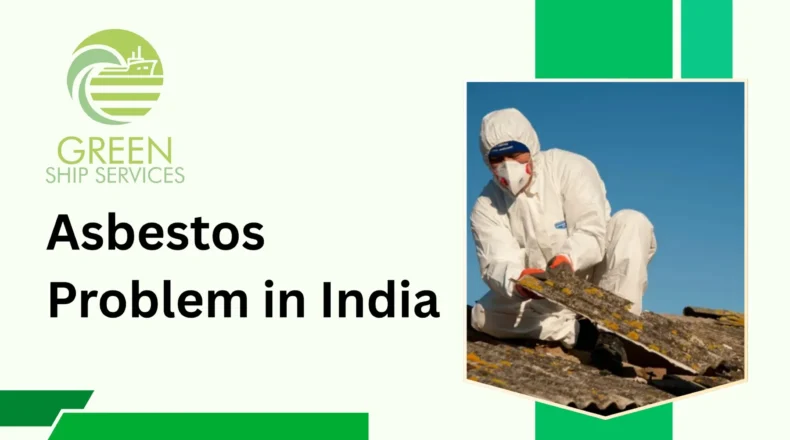Hello Reader!
Welcome to the blog page of Greenship Services, one of the best Asbestos Removal Service in India.
Asbestos, once considered a “miracle material” for its durability, heat resistance, and affordability, has now become one of the most dangerous public health concerns worldwide. While many countries have completely banned asbestos, the Asbestos Problem in India continues to pose a severe risk to millions of people. Despite growing awareness, asbestos is still widely used in construction, roofing sheets, pipes, insulation, and various industrial products across the country.
At Greenship Services, a trusted Asbestos Removal Service in India, we strongly believe it’s time to address this silent killer that hides in our homes, offices, and factories.

Why Asbestos Is Dangerous
The main danger lies in asbestos fibers. When materials containing asbestos break, wear down, or are disturbed, these tiny fibers are released into the air. Once inhaled, they can remain in the lungs for years, leading to life-threatening conditions such as:
- Asbestosis – a chronic lung disease caused by scarring of lung tissue.
- Lung cancer – often seen in workers exposed to asbestos dust.
- Mesothelioma – a rare and aggressive cancer directly linked to asbestos exposure.
Unfortunately, the Asbestos Problem in India is worsened by the lack of awareness and weak regulation in handling these hazardous materials.
Current Situation of the Asbestos Problem in India
India is one of the world’s largest importers of asbestos, especially chrysotile (white asbestos). Even though global health organizations like the World Health Organization (WHO) have warned against its use, the material continues to find its way into:
- Low-cost housing and roofing
- Water pipelines
- Construction insulation
- Automobile brake pads and gaskets
This widespread use means millions of Indians, including construction workers, factory laborers, and even families living under asbestos roofs, are at risk every day.
The Asbestos Problem in India is not only an environmental hazard but also a social and economic challenge. Families dealing with asbestos-related diseases often face high medical expenses, job loss, and reduced quality of life.
Why Professional Removal Matters
Asbestos cannot be removed safely without expertise. Attempting to remove asbestos without proper equipment can release even more harmful fibers into the air. This is why specialized Asbestos Removal Service in India providers like Greenship Services play a crucial role.
Professional asbestos removal ensures:
- Safe inspection and identification of asbestos-containing materials
- Use of protective gear and advanced removal techniques
- Proper disposal of asbestos waste as per safety guidelines
- Reducing long-term health risks for families, workers, and communities
By choosing a professional Asbestos Removal Service in India, property owners can protect their loved ones and employees from serious health threats.
Also Read: Understanding the Risks of Asbestos in Soil: What You Need to Know

What historical factors explain why the asbestos problem in India persists?
The persistence of the asbestos problem in India can be traced to historical, economic, and regulatory factors that have shaped the industry and public health landscape over time.
Early Industry Formation and Colonial Legacy
The asbestos industry began in India in 1934 when British company Turner and Newall Ltd. established the first asbestos-cement factory in Kymore, Madhya Pradesh. Asbestos was promoted as a cheap, durable, and heat-resistant material, and its use quickly spread in construction, manufacturing, and automotive sectors. Economic growth and urbanization during the mid-20th century led to a boom in asbestos demand, with little awareness of its health risks and limited labor protection for workers.
Economic Drivers and Political Influence
Asbestos remains popular in India due to its low cost and suitability for mass housing and infrastructure projects, especially in rural areas. The industry employs hundreds of thousands of workers and is a significant contributor to the economy, which has made regulatory action politically sensitive. Powerful importers and manufacturers have lobbied for continued use and trade, influencing both policy and public messaging.
Weak Enforcement and Gradual Regulation
India banned asbestos mining in 1993 but continued importing chrysotile asbestos largely for use in asbestos-cement products. Tariffs on asbestos imports were reduced from 78% in the 1990s to 15% in 2004, making it even more accessible and attractive to industry. Unlike countries that enacted full bans and strong health regulations, India took gradual measures with minimal restrictions, which allowed the market to grow despite overwhelming evidence of the material’s dangers.
Informal Sector Risks and Lack of Awareness
A large segment of the workforce in the asbestos industry operates in the informal sector, where protections are limited and health monitoring is weak. Many workers lack awareness of long-term health risks, and symptoms often appear decades after exposure, leading to underdiagnosis and minimal reporting of related diseases. Cultural beliefs and fatalism sometimes hinder recognition of occupational hazards.
International and Governmental Reluctance
India has opposed adding chrysotile asbestos to international hazardous chemical lists (such as at the Rotterdam Convention) to avoid stricter regulations. Economic interests consistently outweigh health concerns, leading to a legacy of weak enforcement and ongoing trade in asbestos products.

What steps should you take before hiring an asbestos removal service in India?
Before hiring an asbestos removal service in India, it is essential to take specific preparatory steps to ensure safety, compliance, and effective remediation.
Steps to Take Before Hiring
1. Conduct an Asbestos Survey or Testing
- Arrange for an accredited asbestos survey to confirm the presence, type, and extent of asbestos in your property.
- Reliable testing helps determine the appropriate removal process and risks involved.
2. Research Licensed and Certified Companies
- Choose only authorized and experienced asbestos removal services. Verify licenses, certifications, and compliance with hazardous waste and worker safety regulations.
- Look for companies with at least 10 years of experience and good client reviews.
3. Assess Removal Protocols and Equipment
- Ask about their removal methods, containment procedures, and the safety equipment used (HEPA filters, decontamination units, polythene sheets).
- Confirm adherence to strict government-approved protocols for worker protection and air quality management.
4. Get Detailed Written Quotes and Timelines
- Request comprehensive written quotes covering surveys, removal, waste packaging, transport, and disposal.
- Clarify the project timeline, from site assessment through disposal, and ensure deadlines can be met.
5. Verify Waste Disposal Compliance
- Confirm that the service uses legal hazardous waste disposal sites and meets all Asbestos Waste Management Rules in India.
- Ensure double-sealed, labeled packaging and secure transportation for hazardous material.
6. Ask for References and Past Project Details
- Review testimonials or client feedback to gauge reliability and service quality.
- Check for experience with similar property types (industrial, commercial, residential).
The Way Forward
To truly solve the Asbestos Problem in India, stronger government regulations, widespread awareness campaigns, and affordable alternatives to asbestos are urgently needed. However, until complete bans are enforced, safe handling and removal remain the primary means of minimizing the risks.
At Greenship Services, we are committed to making homes, schools, offices, and factories safer by providing expert Asbestos Removal Service in India. With trained professionals, modern equipment, and strict adherence to safety protocols, we ensure asbestos is eliminated without putting lives at risk.

How might stricter bans on chrysotile asbestos change public health outcomes?
Stricter bans on chrysotile asbestos would result in major improvements in public health outcomes by dramatically reducing exposure to cancer-causing fibers, lowering disease rates, and safeguarding future generations.
Reduction in Disease Rates
Countries that implemented comprehensive asbestos bans have seen marked declines in mesothelioma, lung cancer, and asbestosis cases, as exposure to airborne fibers is nearly eliminated. For example, following bans in the UK and Australia, mesothelioma deaths and new cases of asbestosis have substantially dropped, with health experts predicting continued downward trends for decades.
- Mesothelioma deaths in the UK dropped from 2,526 (2017) to 2,369 (2019) after stricter bans.
- Asbestos-related lung cancer rates and respiratory illnesses decrease in populations no longer exposed occupationally or environmentally.
Protection of Vulnerable Groups
Immediate bans particularly benefit workers in construction, manufacturing, and demolition sectors, who are most at risk. Children and people with respiratory conditions also experience improved health due to reduced exposure, especially in older buildings and community spaces. Public awareness campaigns and safer workplaces further enhance community health standards.
Lower Health Care Costs and Improved Quality of Life
With fewer cases of asbestos-induced diseases, nations save substantial resources previously dedicated to treating chronic and fatal conditions like lung cancer and mesothelioma. Family burdens are eased, life expectancy rises, and communities remain safer for generations.
Long-Term Outcomes
Because diseases caused by chrysotile asbestos have long latency periods, the full health benefits will be realized over decades. Early bans in countries like Sweden and Australia show significant long-term declines in disease rates, demonstrating the effectiveness of this policy.

What short-term harms might arise from removing existing chrysotile materials?
Removing existing chrysotile asbestos materials can cause several short-term harms, primarily due to the release of asbestos fibers into the air during disturbance and removal, which poses acute respiratory and contamination risks.
Short-Term Harms from Removing Chrysotile
1. Exposure to Airborne Asbestos Fibers
- Disturbing chrysotile materials in removal can release respirable asbestos fibers that, when inhaled, irritate the lungs and cause immediate respiratory symptoms such as coughing, shortness of breath, and throat irritation.
- Even brief high-level exposure increases the risk of developing irritation and inflammation in the respiratory tract.
2. Acute Inflammation and Lung Irritation
- Short-term exposure can cause lung inflammation, leading to symptoms like chest tightness, wheezing, and occasional respiratory distress especially in sensitive individuals.
- Workers and nearby occupants may experience eye, nose, and throat irritation during removal activities if safety protocols are not strictly followed.
3. Secondary Exposure Risks
- Asbestos fibers can spread beyond the immediate removal site to contaminate clothing, tools, and adjacent areas, putting family members or co-workers at risk through secondary exposure.
4. Contamination of Environment and Property
- Improper containment during removal risks asbestos dust settling on floors, furniture, ventilation systems, or soil, creating short-term environmental hazards that require extensive cleaning and control.
5. Psychological Stress and Disruption
- The process of asbestos removal often disrupts living or working environments, causing stress and anxiety for occupants concerned about exposure and health impacts.
Mitigation Through Safe Removal Practices
These short-term harms underscore the need for strict adherence to safety protocols including wetting asbestos to prevent dust, using protective gear, containment barriers, and thorough cleanup. Professional asbestos removal services use specialized equipment and expert methods to minimize these short-term risks and protect health during chrysotile asbestos abatement.

FAQ
1. Why is asbestos still a problem in India?
Asbestos is widely used in roofing sheets, pipes, and construction materials due to its low cost. Lack of strict regulations and awareness has kept the Asbestos Problem in India alive, despite its proven health risks.
2. What health issues are linked to asbestos exposure?
Asbestos exposure can cause serious diseases such as asbestosis, lung cancer, and mesothelioma, making it a major long-term health threat.
3. Is asbestos banned in India?
No, asbestos is not completely banned in India. While some forms are restricted, white asbestos (chrysotile) is still imported and widely used.
4. How can asbestos be removed safely?
Safe removal requires trained experts with protective equipment and proper disposal methods. Hiring a professional Asbestos Removal Service in India ensures safe handling and minimizes health risks.
5. What should I do if I suspect asbestos in my home or workplace?
Do not disturb or try to remove it yourself. Contact a certified Asbestos Removal Service in India to inspect, manage, and safely remove the material.
Conclusion
The Asbestos Problem in India is not just a health concern—it’s a ticking time bomb that affects our environment, economy, and most importantly, the lives of millions. The danger of asbestos exposure is real, but with timely intervention and professional services, the threat can be reduced.
If you suspect asbestos in your building, don’t ignore it. Consult a certified Asbestos Removal Service in India like Greenship Services to safeguard your health and future.
